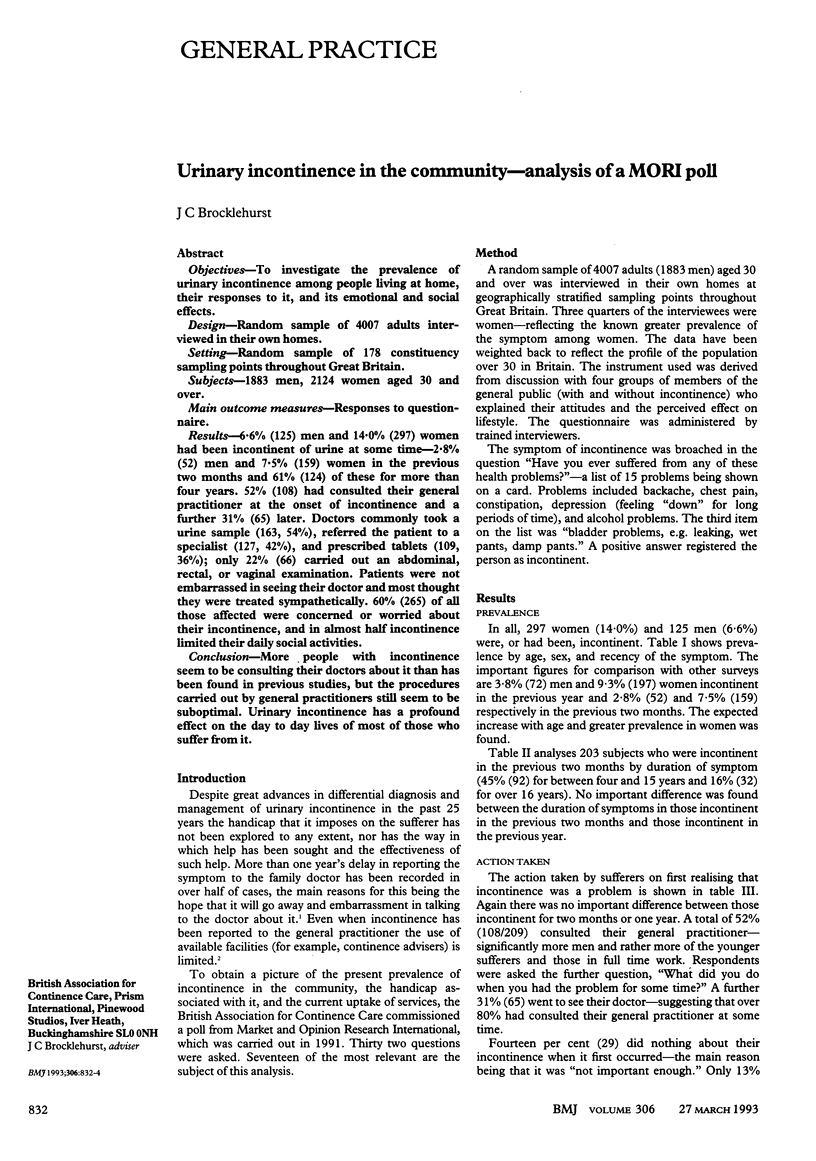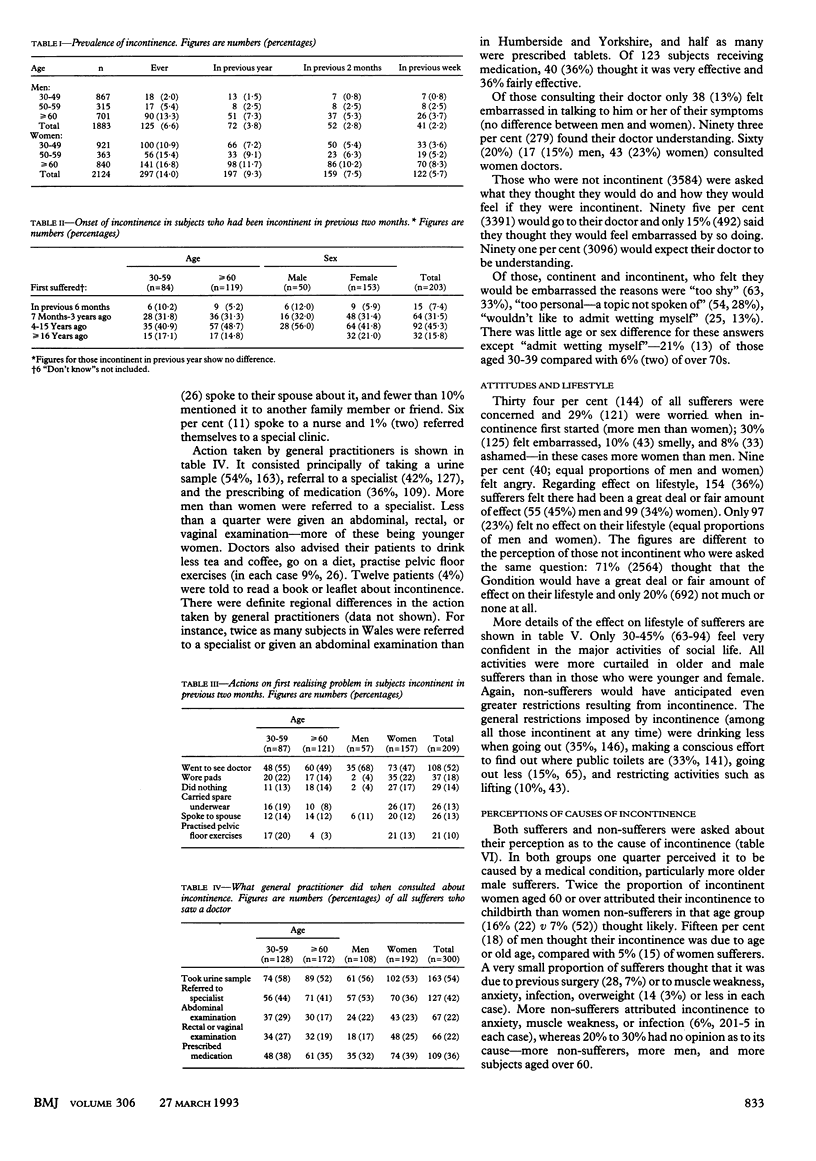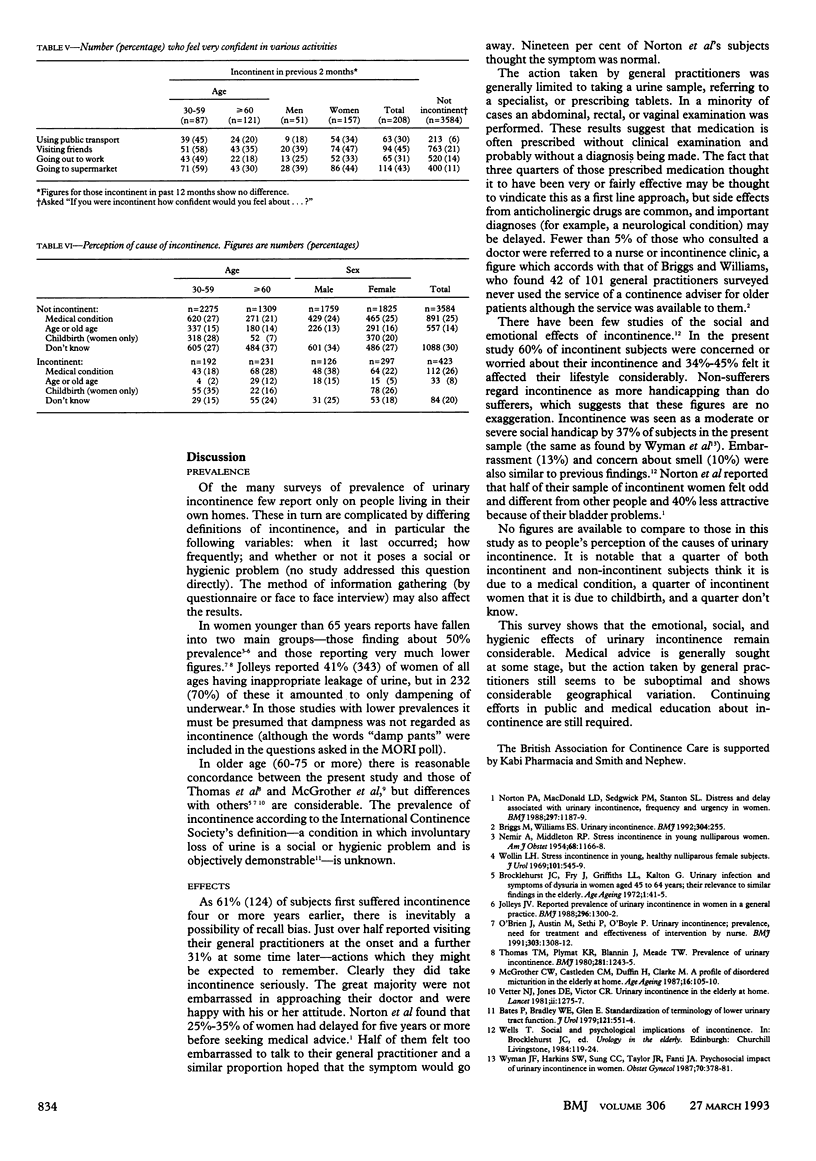Abstract
OBJECTIVES--To investigate the prevalence of urinary incontinence among people living at home, their responses to it, and its emotional and social effects. DESIGN--Random sample of 4007 adults interviewed in their own homes. SETTING--Random sample of 178 constituency sampling points throughout Great Britain. SUBJECTS--1883 men, 2124 women aged 30 and over. MAIN OUTCOME MEASURES--Responses to questionnaire. RESULTS--6.6% (125) men and 14.0% (297) women had been incontinent of urine at some time--2.8% (52) men and 7.5% (159) women in the previous two months and 61% (124) of these for more than four years. 52% (108) had consulted their general practitioner at the onset of incontinence and a further 31% (65) later. Doctors commonly took a urine sample (163, 54%), referred the patient to a specialist (127, 42%), and prescribed tablets (109, 36%); only 22% (66) carried out an abdominal, rectal, or vaginal examination. Patients were not embarrassed in seeing their doctor and most thought they were treated sympathetically. 60% (265) of all those affected were concerned or worried about their incontinence, and in almost half incontinence limited their daily social activities. CONCLUSION--More people with incontinence seem to be consulting their doctors about it than has been found in previous studies, but the procedures carried out by general practitioners still seem to be suboptimal. Urinary incontinence has a profound effect on the day to day lives of most of those who suffer from it.
Full text
PDF


Selected References
These references are in PubMed. This may not be the complete list of references from this article.
- Bates P., Bradley W. E., Glen E., Griffiths D., Melchior H., Rowan D., Sterling A., Zinner N., Hald T. The standardization of terminology of lower urinary tract function. J Urol. 1979 May;121(5):551–554. doi: 10.1016/s0022-5347(17)56874-3. [DOI] [PubMed] [Google Scholar]
- Briggs M., Williams E. S. Urinary incontinence. BMJ. 1992 Jan 25;304(6821):255–255. doi: 10.1136/bmj.304.6821.255. [DOI] [PMC free article] [PubMed] [Google Scholar]
- Jolleys J. V. Reported prevalence of urinary incontinence in women in a general practice. Br Med J (Clin Res Ed) 1988 May 7;296(6632):1300–1302. doi: 10.1136/bmj.296.6632.1300. [DOI] [PMC free article] [PubMed] [Google Scholar]
- Lock S. NHS 1948-88: less ideology, more humanity. BMJ. 1988 Jul 2;297(6640):1–3. doi: 10.1136/bmj.297.6640.1. [DOI] [PMC free article] [PubMed] [Google Scholar]
- McGrother C. W., Castleden C. M., Duffin H., Clarke M. A profile of disordered micturition in the elderly at home. Age Ageing. 1987 Mar;16(2):105–110. doi: 10.1093/ageing/16.2.105. [DOI] [PubMed] [Google Scholar]
- NEMIR A., MIDDLETON R. P. Stress incontinence in young nulliparous women; a statistical study. Am J Obstet Gynecol. 1954 Oct;68(4):1166–1168. doi: 10.1016/s0002-9378(16)38416-2. [DOI] [PubMed] [Google Scholar]
- O'Brien J., Austin M., Sethi P., O'Boyle P. Urinary incontinence: prevalence, need for treatment, and effectiveness of intervention by nurse. BMJ. 1991 Nov 23;303(6813):1308–1312. doi: 10.1136/bmj.303.6813.1308. [DOI] [PMC free article] [PubMed] [Google Scholar]
- Thomas T. M., Plymat K. R., Blannin J., Meade T. W. Prevalence of urinary incontinence. Br Med J. 1980 Nov 8;281(6250):1243–1245. doi: 10.1136/bmj.281.6250.1243. [DOI] [PMC free article] [PubMed] [Google Scholar]
- Vetter N. J., Jones D. A., Victor C. R. Urinary incontinence in the elderly at home. Lancet. 1981 Dec 5;2(8258):1275–1277. doi: 10.1016/s0140-6736(81)91504-x. [DOI] [PubMed] [Google Scholar]
- Wolin L. H. Stress incontinence in young, healthy nulliparous female subjects. J Urol. 1969 Apr;101(4):545–549. doi: 10.1016/s0022-5347(17)62378-4. [DOI] [PubMed] [Google Scholar]
- Wyman J. F., Harkins S. W., Choi S. C., Taylor J. R., Fantl J. A. Psychosocial impact of urinary incontinence in women. Obstet Gynecol. 1987 Sep;70(3 Pt 1):378–381. [PubMed] [Google Scholar]


